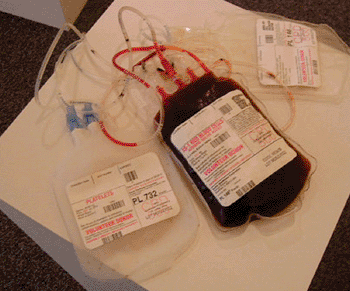Blood Transfusion Practice Wastes Scarce Plasma
By LabMedica International staff writers
Posted on 30 Jul 2013
The use of a blood transfusion protocol in patients with severe trauma is feasible in hospitals, although it is associated with higher waste of plasma.Posted on 30 Jul 2013
The protocol, in use since 2007, uses an equal ratio of red blood cells, plasma, and platelets to transfuse patients, yet this 1:1:1 ratio is associated with higher waste of donated blood plasma.

Image: Donor Blood Separation (Photo courtesy of Puget Sound Blood Center).
Scientists at the Sunnybrook Health Sciences Center (Toronto, ON, Canada) conducted a randomized trial to determine feasibility and safety of 1:1:1 ratio in 78 patients presenting in a large trauma center, with low blood pressure and substantial bleeding who were expected to need massive blood transfusion. Forty patients were randomly assigned to the fixed-ratio transfusion, and the remaining 38 underwent the laboratory-guided transfusion protocol at the center.
Thawed type AB plasma, a scarce resource, is needed for 1:1:1 transfusion, which also involves delays because of the need to thaw the material. Deaths from all causes after 28 days was higher in the fixed-ratio group at 32.5% compared with 14% in the control group and there was a higher rate of respiratory distress in the patients receiving 1:1:1.
Sandro Rizoli, MD, PhD, a professor of surgery and senior author of the study, said, “These findings suggest that a fixed-ratio transfusion protocol is feasible, but it was associated with increased plasma wastage, about two units per patient”. Widespread adoption of the 1:1:1 strategy has significant resource and safety implications. Its full implementation requires access to thawed type AB plasma, which is chronically in short supply. The 1:1:1 transfusion protocol may lead to unnecessary exposure to blood components and an increased risk of acute respiratory distress syndrome, sepsis, and multiple organ dysfunctions.
The authors concluded that the randomized controlled trial showed the implementation of a fixed-ratio (1:1:1) transfusion protocol was feasible among patients with severe trauma. The full and widespread implementation of such a protocol will challenge blood suppliers because of the increased demand and wastage of plasma. Larger clinical trials are warranted to definitively evaluate the efficacy and safety of transfusion at a 1:1:1 ratio. The study was published on July 15, 2013, in the Canadian Medical Association Journal.
Related Links:
Sunnybrook Health Sciences Center














